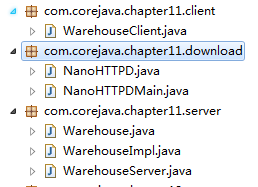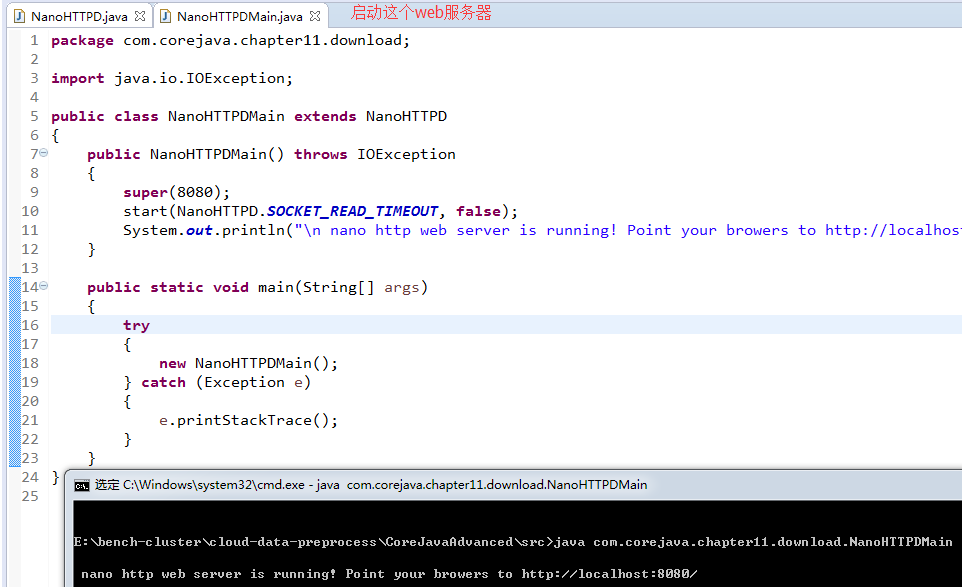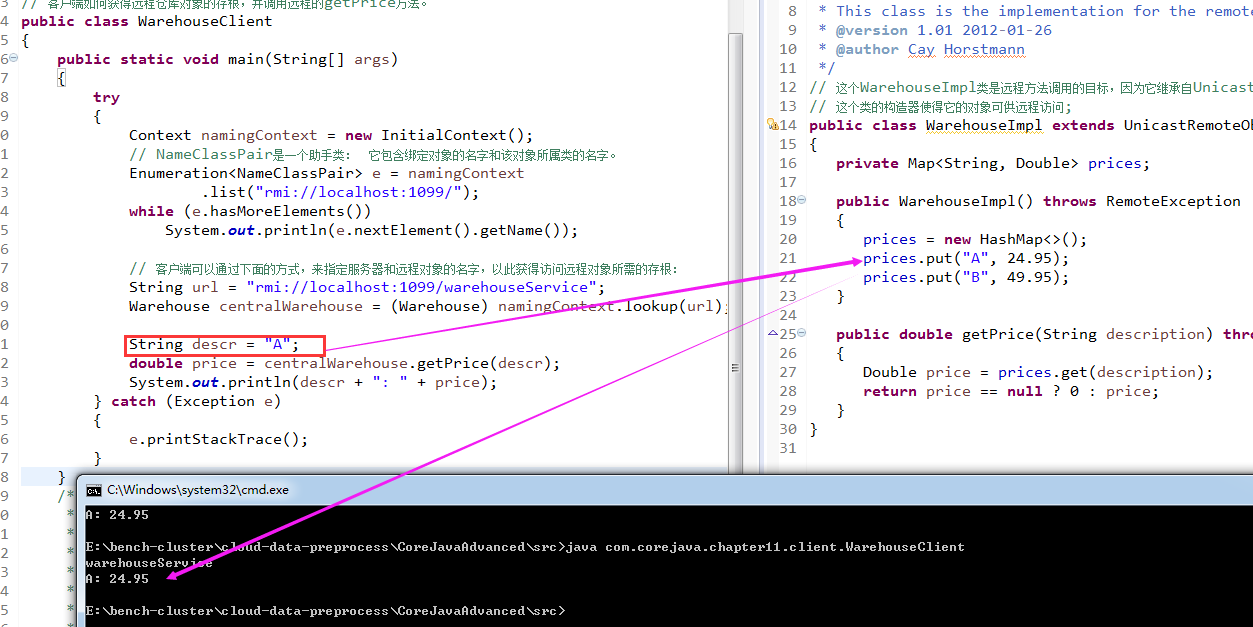java分布式对象RMI应用测试用例
2016-02-20 16:59
531 查看
【0】README
0.1)本文旨在对http://blog.csdn.net/PacosonSWJTU/article/details/50705192 中的代码进行实践(如何部署一个使用RMI框架的程序以进行远程调用);
0.2) for complete source code, please visit https://github.com/pacosonTang/core-java-volume/tree/master/coreJavaAdvanced/chapter11/rmi_test
0.3)目录结构如下:

【1】部署前的准备
step1)创建两个目录, 分别存放用于启动server 和 client 的类:
server/
WarehouseServer.class
Warehouse.class
WarehouseImpl.class
client/
WarehouseClient.class
Warehouse.class
step2)创建download 目录,用于存放 NanoHTTPD web server
【1】部署步骤如下
step1)打开一个新的控制台窗口,转到download目录,然后将NanoHTTPD.java(NanoHTTPD
web 服务器)复制到这个目录中。(NanoHTTPD web 服务器的源代码 ,参见, https://github.com/pacosonTang/core-java-volume/tree/master/coreJavaAdvanced/chapter11/rmi_test)

step2)在server 程序中通过代码注册通讯端口和注册通讯路径
step3)现在已经准备好启动服务器了。打开第三个控制台窗口,转到server目录,并执行下面的命令:


0.1)本文旨在对http://blog.csdn.net/PacosonSWJTU/article/details/50705192 中的代码进行实践(如何部署一个使用RMI框架的程序以进行远程调用);
0.2) for complete source code, please visit https://github.com/pacosonTang/core-java-volume/tree/master/coreJavaAdvanced/chapter11/rmi_test
0.3)目录结构如下:

【1】部署前的准备
step1)创建两个目录, 分别存放用于启动server 和 client 的类:
server/
WarehouseServer.class
Warehouse.class
WarehouseImpl.class
client/
WarehouseClient.class
Warehouse.class
step2)创建download 目录,用于存放 NanoHTTPD web server
【1】部署步骤如下
step1)打开一个新的控制台窗口,转到download目录,然后将NanoHTTPD.java(NanoHTTPD
web 服务器)复制到这个目录中。(NanoHTTPD web 服务器的源代码 ,参见, https://github.com/pacosonTang/core-java-volume/tree/master/coreJavaAdvanced/chapter11/rmi_test)
<span style="font-size:14px;">package com.corejava.chapter11.download;
import java.io.IOException;
public class NanoHTTPDMain extends NanoHTTPD
{
public NanoHTTPDMain() throws IOException
{
super(8080);
start(NanoHTTPD.SOCKET_READ_TIMEOUT, false);
System.out.println("\n nano http web server is running! Point your browers to http://localhost:8080/ \n");
}
public static void main(String[] args)
{
try
{
new NanoHTTPDMain();
} catch (Exception e)
{
e.printStackTrace();
}
}
}
</span>
step2)在server 程序中通过代码注册通讯端口和注册通讯路径
<span style="font-size:14px;">public class WarehouseServer
{
public static void main(String[] args)
{
try
{
WarehouseImpl warehouseService = new WarehouseImpl();
// 注册通讯端口
LocateRegistry.createRegistry(1099);
// 注册通讯路径
Naming.rebind("rmi://localhost:1099/warehouseService", warehouseService);
System.out.println("warehouse service starts");
} catch (Exception e)
{
e.printStackTrace();
}
}
}</span><span style="font-size:14px;">// 这个WarehouseImpl类是远程方法调用的目标,因为它继承自UnicastRemoteObject,
// 这个类的构造器使得它的对象可供远程访问;
public class WarehouseImpl extends UnicastRemoteObject implements Warehouse
{
private Map<String, Double> prices;
public WarehouseImpl() throws RemoteException
{
prices = new HashMap<>();
prices.put("A", 24.95);
prices.put("B", 49.95);
}
public double getPrice(String description) throws RemoteException
{
Double price = prices.get(description);
return price == null ? 0 : price;
}
}</span><span style="font-size:14px;">// 远程对象的接口必须扩展Remote接口
public interface Warehouse extends Remote
{
double getPrice(String description) throws RemoteException;
}
</span>step3)现在已经准备好启动服务器了。打开第三个控制台窗口,转到server目录,并执行下面的命令:
java -Djava.rmi.server.codebase=http://localhost:8080/ WarehouseServer // java.rmi.server.codebase属性指出了服务类文件的URL。服务器程序将这个URL传递给RMI注册表。

step4)最后,打开第四个控制台窗口,转到client目录,运行:

<span style="font-size:14px;">// 客户端如何获得远程仓库对象的存根,并调用远程的getPrice方法。
public class WarehouseClient
{
public static void main(String[] args)
{
try
{
Context namingContext = new InitialContext();
// NameClassPair是一个助手类: 它包含绑定对象的名字和该对象所属类的名字。
Enumeration<NameClassPair> e = namingContext
.list("rmi://localhost:1099/");
while (e.hasMoreElements())
System.out.println(e.nextElement().getName());
// 客户端可以通过下面的方式,来指定服务器和远程对象的名字,以此获得访问远程对象所需的存根:
String url = "rmi://localhost:1099/warehouseService";
Warehouse centralWarehouse = (Warehouse) namingContext.lookup(url);
String descr = "A";
double price = centralWarehouse.getPrice(descr);
System.out.println(descr + ": " + price);
} catch (Exception e)
{
e.printStackTrace();
}
}}</span>
相关文章推荐
- jvm学习笔记二(java内存分配策略和回收策略)
- Android SDK镜像的介绍使用(eclipse)
- 详解java垃圾回收机制
- java(16)--利用cookie显示商品浏览历史
- Java Base64 加密解密
- java非对称加密算法原理及应用
- Java 集合系列04之 fail-fast总结(通过ArrayList来说明fail-fast的原理、解决办法)
- Spring 基于 annotation 的自动装配
- java非对称加密算法原理及应用
- 面向对象02--java基础
- Spring事务传递性探讨
- Spring事务传递性探讨
- java多态学习
- spring学习——配置文件
- Java认证考试实例疑难辨析(12)
- spring MVC文件上传和下载
- Java设计模式 工厂模式
- Fragment使用时出现 java.lang.IllegalStateException
- Java编程思想读书笔记 第1章 对象导论
- java文件复制,重命名
